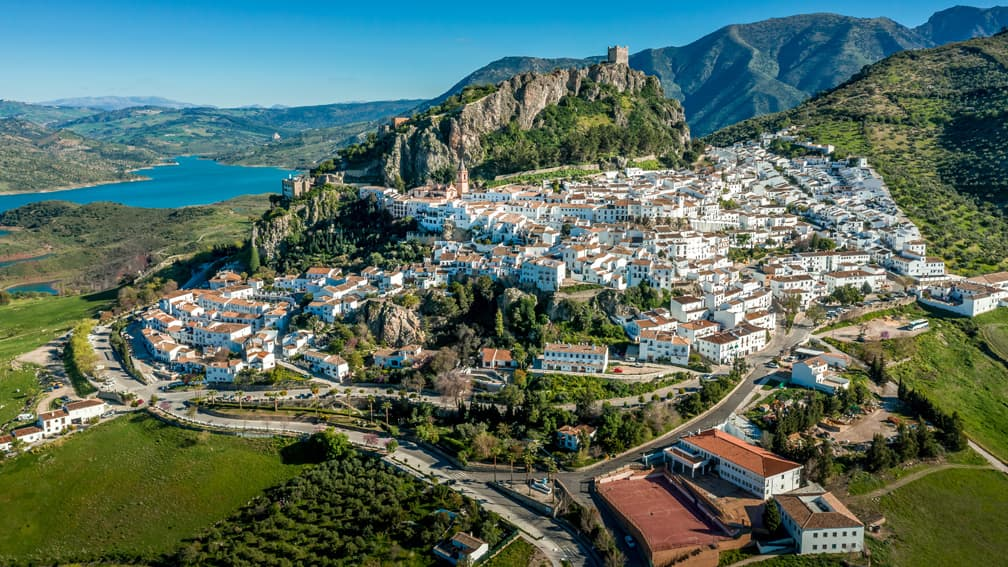Nestled in the heart of Andalusia, Zahara de la Sierra stands as one of Spain’s white villages, or pueblos blancos, offering a timeless blend of historical charm and natural beauty. Located in the province of Cádiz, this picturesque town is perched on a rocky hilltop, with its whitewashed houses and cobbled streets making it a quintessential Andalusian destination.
From its ancient Moorish fortress to its breathtaking views of the surrounding countryside, Zahara de la Sierra is more than just a village – it’s a window into Spain’s rich cultural tapestry, echoing centuries of history, tradition, and architectural splendor.
Zahara de la Sierra is a hidden gem that captivates all who visit. Its stunning beauty and peaceful atmosphere make it a place where time seems to stand still. Whether you’re seeking an escape into nature, a journey through history, or simply a serene retreat, this white village offers a slice of Spanish life that is both authentic and unforgettable.
The Geography of Zahara de la Sierra
Zahara de la Sierra is situated in the Sierra de Grazalema Natural Park, one of the most important natural parks in Andalusia. The village itself is perched atop a steep hill, offering panoramic views of the lush valleys and rugged mountains that surround it.
Read : Spain: Where Blissful Sunsets Meet the Echoes of Forgotten Sorrow
The Sierra de Grazalema is known for its dramatic landscapes, with limestone peaks, deep gorges, and forests of cork oak and pine dominating the terrain. Zahara sits on the edge of a reservoir, the Embalse de Zahara-El Gastor, which adds to the village’s scenic beauty.
Read : Viva España: Exploring the Top Places to Visit in Spain
This prime location not only provides breathtaking vistas but also offers visitors access to some of the most beautiful hiking trails in the region. The natural park is home to a wide variety of flora and fauna, making it a paradise for nature lovers.
The nearby peaks of the Sierra de Grazalema offer adventure enthusiasts ample opportunities for hiking, rock climbing, and bird watching, with vultures and eagles often spotted soaring through the sky.
A Rich Historical Tapestry
Zahara de la Sierra’s history is as rich as its natural surroundings. Its origins date back to the Roman era, but it is most well-known for its role during the Moorish period in Spain. The Moors recognized the strategic importance of Zahara’s location and fortified the town, turning it into an impregnable stronghold.
The town’s crowning jewel, the Torre del Homenaje, is a remnant of its Moorish past. This ancient watchtower, perched at the highest point of the village, was built to defend the town from invaders and offers a glimpse into Zahara’s military significance during the Middle Ages.
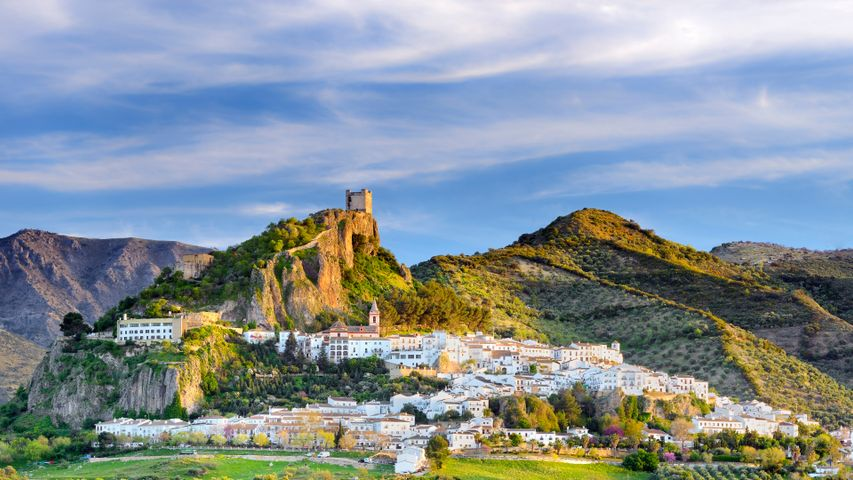
In 1407, Zahara was taken by Christian forces during the Reconquista, but it was later recaptured by the Moors in 1481. This marked one of the final episodes of Moorish rule in Spain before the eventual fall of Granada in 1492. Zahara’s strategic location on the frontier between Christian and Moorish territories made it a focal point of conflict during this tumultuous period.
Today, the ruins of the castle and the Torre del Homenaje stand as a testament to Zahara’s historical significance, offering visitors a chance to step back in time and imagine the town’s past as a contested battleground.
The Whitewashed Beauty of Zahara
The defining feature of Zahara de la Sierra, and what sets it apart from other Spanish villages, is its dazzling whitewashed buildings. The tradition of painting houses white is not unique to Zahara but is a hallmark of the pueblos blancos of Andalusia.
The practice dates back centuries and was originally intended to reflect the intense heat of the Andalusian sun. Today, it serves as both a practical and aesthetic feature, giving the village its iconic appearance.
Wandering through the narrow, winding streets of Zahara is like stepping into a postcard. The houses, adorned with colorful flowers and wrought-iron balconies, provide a striking contrast to the deep blue skies and the green hills that surround the village.
The white facades, combined with the red-tiled roofs, create a picturesque setting that is quintessentially Andalusian. Zahara’s streets are steep and cobbled, adding to the charm and making each turn an opportunity to discover something new – whether it’s a hidden courtyard, a quiet café, or a scenic overlook.
Exploring Zahara’s Landmarks
While the entire village of Zahara de la Sierra feels like a living museum, there are several landmarks that are particularly noteworthy.
The Church of Santa María de la Mesa is a stunning example of Baroque architecture. Built in the 17th century, this church is the spiritual heart of Zahara and features an impressive bell tower that dominates the skyline. Its interior is equally captivating, with beautiful altarpieces and religious artwork that reflect the town’s deep Catholic roots.
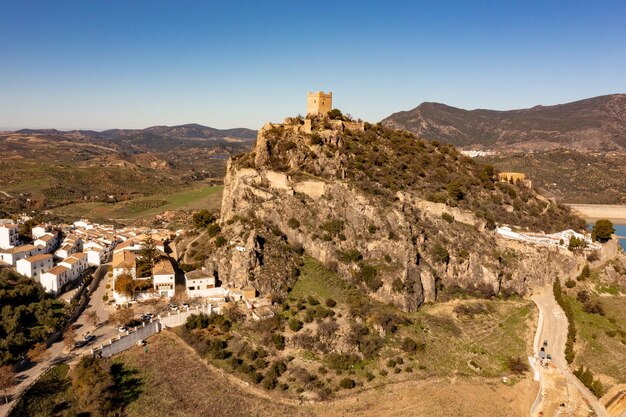
The Torre del Homenaje, as previously mentioned, is one of Zahara’s most iconic landmarks. Climbing to the top of this tower is a must for any visitor, as the views from here are simply breathtaking. From this vantage point, you can see the entire village, the surrounding mountains, and the shimmering reservoir below.
The sense of history is palpable as you stand on the ancient stones of this medieval fortress, imagining the battles that were fought here centuries ago.
Another point of interest is the Arco de la Villa, an ancient gateway that once served as the entrance to the fortified town. Walking through this archway feels like passing through a portal into the past. It’s a reminder of Zahara’s defensive role during the Moorish-Christian conflicts and adds to the town’s historic ambiance.
The Reservoir: Embalse de Zahara-El Gastor
One of Zahara de la Sierra’s most striking features is its proximity to the Embalse de Zahara-El Gastor, a large reservoir that adds to the village’s scenic beauty. The reservoir is a popular spot for water-based activities such as kayaking, swimming, and paddleboarding.
The calm, clear waters of the reservoir provide a perfect contrast to the rugged hills that rise above it, making it an ideal location for outdoor enthusiasts looking to explore the natural beauty of the region.
In the summer months, the reservoir becomes a hub of activity, with locals and tourists alike flocking to its shores to escape the heat and enjoy the refreshing water. There are also several beaches along the reservoir’s edge where visitors can relax, sunbathe, or have a picnic while taking in the stunning views.
Zahara’s Festivals and Traditions
Like many small villages in Spain, Zahara de la Sierra is deeply rooted in tradition, and this is especially evident in the various festivals and celebrations that take place throughout the year. One of the most important events in Zahara is Semana Santa, or Holy Week, which is celebrated with great fervor and devotion.
During this time, processions fill the streets, with locals carrying religious statues and icons through the village as part of a larger commemoration of the Passion of Christ. The somber yet beautiful atmosphere during Semana Santa is a reflection of the village’s deep Catholic faith.
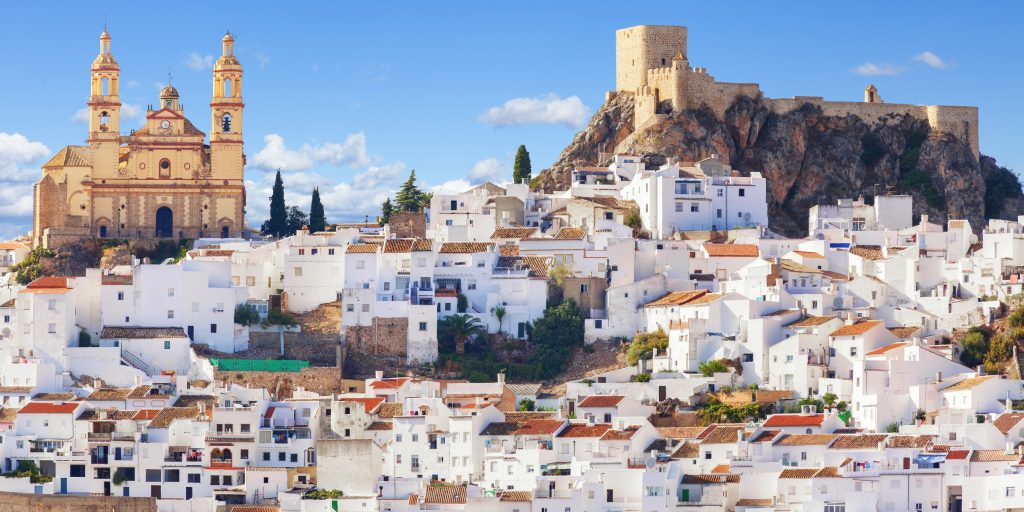
Another significant event is the Romería de Zahara, a pilgrimage that takes place in May. The entire village participates in this religious and cultural event, where locals, dressed in traditional Andalusian attire, make their way to a nearby chapel to honor the Virgin Mary.
The Romería is a joyful occasion, with singing, dancing, and feasting, and offers a glimpse into the strong sense of community and tradition that defines life in Zahara.
The Gastronomy of Zahara de la Sierra
No visit to Zahara de la Sierra would be complete without experiencing its local cuisine. The gastronomy of Zahara, like much of Andalusia, is simple yet flavorful, making use of locally sourced ingredients and traditional cooking methods. Olive oil, fresh vegetables, and meats are staples of the local diet, and the village is known for its hearty and rustic dishes.
One of the must-try dishes in Zahara is gazpacho, a cold tomato-based soup that is perfect for the hot Andalusian summers. Another local favorite is salmorejo, a thicker version of gazpacho that is often served with boiled eggs and ham. For those with a heartier appetite, rabo de toro (oxtail stew) is a popular dish, as is chorizo al vino (chorizo sausage cooked in wine).
Zahara is also part of the famous olive oil route, and the region’s olive oil is some of the best in Spain. Visitors can take part in olive oil tastings or visit nearby olive farms to learn about the production process. Olive oil is a key ingredient in many of Zahara’s dishes, and its high quality is a point of pride for the local community.
A Gateway to the Pueblos Blancos Route
Zahara de la Sierra is just one of the many pueblos blancos that dot the Andalusian landscape. The Ruta de los Pueblos Blancos is a popular tourist route that takes visitors through a series of whitewashed villages, each with its own unique charm and history.
Zahara serves as an excellent starting point for exploring this route, with nearby towns such as Grazalema, Setenil de las Bodegas, and Ronda all offering their own attractions and stunning views.
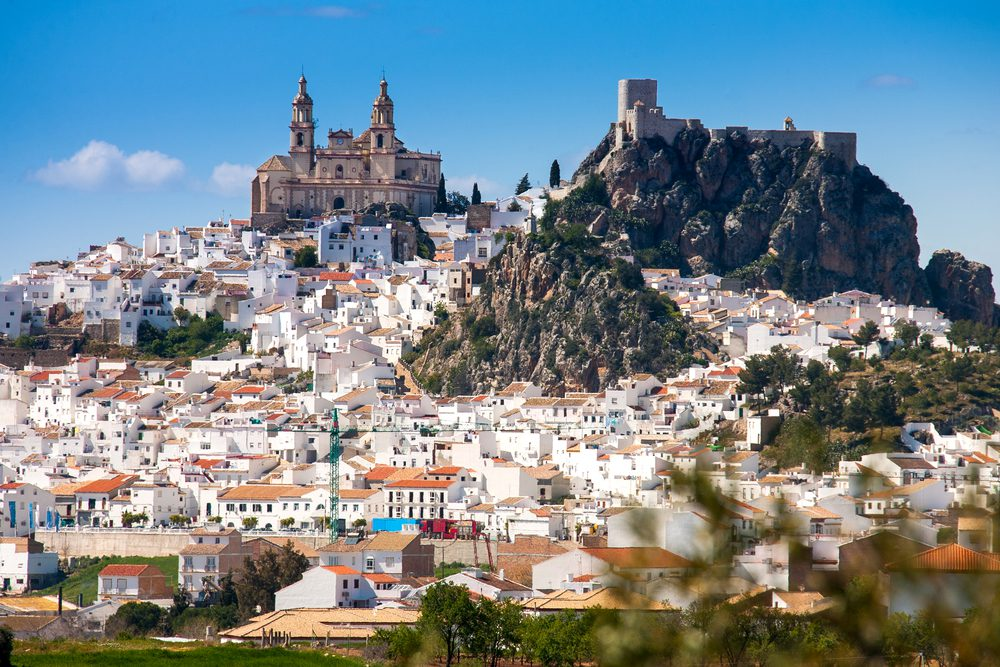
The pueblos blancos are known for their striking appearance, with their whitewashed houses creating a stark contrast against the green hills and rocky cliffs of Andalusia. These villages are steeped in history, with many of them dating back to the Moorish era. Exploring the pueblos blancos is like taking a journey through time, with each village offering its own stories and traditions.
The Appeal of Zahara de la Sierra
Zahara de la Sierra may be small in size, but it offers an abundance of beauty, history, and culture. Its whitewashed streets, ancient fortress, and stunning
natural surroundings make it one of the most enchanting villages in Spain. Whether you’re a history buff, a nature enthusiast, or simply looking to escape the hustle and bustle of modern life, Zahara provides a peaceful retreat that feels a world away from the larger cities of Andalusia.
Visiting Zahara de la Sierra is like stepping into a fairytale. The village’s timeless beauty, coupled with its rich cultural heritage, makes it a destination that lingers in the memory long after you’ve left. Its quiet streets, breathtaking views, and friendly locals create an atmosphere of tranquility and warmth, offering a true taste of Andalusian life.

